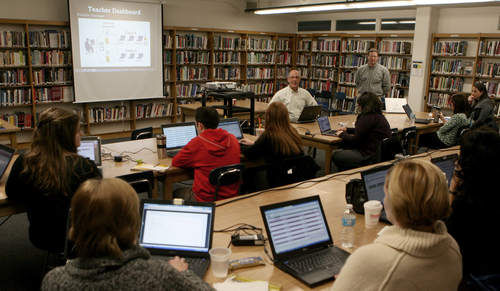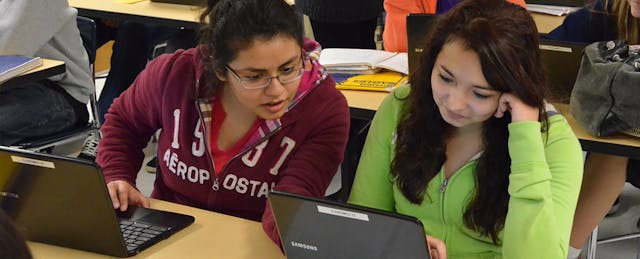Rarely does “professional development” satisfy the needs of every teacher. Many, in fact, are quite vocal about their dissatisfaction. So it was quite surprising that when a panel of teachers at Leyden High School District 212’s second-ever 1:1 Summer Symposium was asked “what was missing” from their edtech PD experience, no one raised any complaints.
From its quiet suburb in Franklin Park, IL, Leyden stands out as an example of how full infrastructure and administrative support contribute to successful 1:1 implementation, even when a district lacks faculty buy-in at the start--as well as how that implementation can shape successful student learning.
Between 2010 and 2014, Leyden has seen a 35% increase in the number of 12th graders performing proficiently in designated “student achievement” areas. District-wide discipline referrals dropped by 40.5% between 2011 and 2014, and Leyden was showcased as 2014’s Advanced Placement national district of the year--an honor given to only three U.S. districts each year. All that in a district with 3400 students, over half of whom qualify for free/reduced lunch.

But the road to 1:1 hasn’t always been easy or simple, and it took, not one or two but the convergence of three committed leaders to make this transition stick.
Here’s what happened. Leyden’s journey began in 1999.
Pilots are learning experiences--especially when they fail (1999-2000)
Leyden got its first T1 bandwidth connection in the late 1990s, but a concerted effort to integrate tech into instruction began in 1999. At that time, Leyden took an ambitious leap of faith with “Model Technology Classrooms,” where a classroom equipped with seven computers for students connected to a Novell network (about 1 computer to 4 students), Internet access, and more. Fifty teachers underwent 65 hours (each) of PD, and each spent two to three of their weekly scheduled classes in these classrooms.
The initiative gained less traction than its designers had expected. David Narter, an English teacher who joined Leyden in 1996, recalls that Leyden admins struggled from the get-go to recruit teachers to take part in the pilot. The initial 50 teachers selected to take part felt disconnected from the technology, Narter says, and saw the program as something that required a lot of work in exchange for little impact.
“I got chosen for the program but I promptly quit,” Narter recalls. “The whole point was to try and figure out what to do with these computers in the classrooms. But it was tried out for a little while and then went away. It didn't have a big impact.”
“It was at the time an ambitious proposal,” concurs Dr. Mikkel Storaasli, who’s been with the district since 1996. “The finances weren't there to give the educators everything they wanted.”
Show--don’t just tell--what you can do with edtech (2001-2005)
The initiative needed a leader--and it found one in 2001 when Leyden teacher Bryan Weinert became Leyden’s District Director of Technology. Weinert pushed for the technologies he saw as vital, and connected Leyden to a world of edtech beyond--something that pushed teachers out of their comfort zone. Narter explains:
“You’d hate [Weinert] one day, and the next day, you're like, ‘How could I hate you, you're solving all my problems!’ I had friends that were like, ‘I have a computer in my lectern,’ and I said, ‘I've got a computer I can take home!’ We did about as much technology-wise as you could do at that time.”
Weinert began to carry out a steady stream of edtech implementation strategies. In 2001, all teachers received laptops; a year later, all teachers received internet access. In 2004, Weinert pushed for district-wide web-based SMS implementation.
"Each day, there was something new," Narter recalls, ticking off computerized gradebooks and web-based SMS implementation with eSchools (essentially, messaging with parents) as the “big things” teachers saw.
But Weinert’s efforts didn’t just bring new initiatives into the district; he also introduced educators to the world of edtech conferences. In 2005, Weinert sent a first cohort of teachers to the annual National Educational Computing Conference (NECC), now known as the ISTE Conference/Expo. Leyden’s teachers began to warm to using technology.
Unsupportive leadership and limited innovations can be edtech deterrents (2006-2009)
And then, the momentum stalled.
Jack Denny, Leyden’s Assistant Superintendent for Curriculum and Instruction and the predominant owner of new initiatives at Leyden, felt differently. In an interview with EdSurge, Denny shares that he focused on what he believed were core needs: “School improvement efforts focused on students' development in disciplinary literacy (skills, content, critical thinking),” Denny says.
Funding and energy around tech implementations significantly slowed down: The only gear the district rolled out between 2006 and 2009 were LCD projectors in 2009.
And although the teachers were equipped with laptops, the students were not--something that stymied changes in teaching practices. According to Storaasli:
“I think we were just limited by the fact that we had reached the limit with a traditional model. We were limited by the fact that students didn't have their devices… If you don't have it every day, if it isn't ubiquitous, you aren't going to really put in the time to use those tools.”
Even administrators need a strong team (2010-2012)
In July 2010, Jack Denny left his post as Assistant Superintendent. In the broader world, excitement was beginning to mount about the potential of using technology to support teachers goals. And the people who came in to lead Leyden were determined to infuse Leyden with energy around changing the tools used to support instruction.
Jason Markey, an educator from Iowa who had taught at Leyden 2003-2008, re-joined Leyden as the East Leyden Assistant Principal in the same month that Mikkel Storaasli became the Assistant Superintendent of Curriculum and Instruction. Both felt excited about education technology, had seen what had and had not worked in the past, and could envision a program that the public would later describe as 1:1.
Leyden’s educators, including Narter, began describing Markey, Storaasli, and Weinert as “the Big Three.” Narter explains:
“You're going to need some evangelizing, some politicking, and a whole lot of buy-in when it comes to edtech. When you got [Markey, Storaasli, and Weinert] together, you really had a powerhouse.”
Weinert was aching to get tech in the hands of students. “Bryan had been thinking about it way before I did,” Storaasli says. “We're pretty conscious of the fact that what we had was limiting. We thought it would be awesome if every kid had a device."
The trio immediately laid out plans for a 1:1 pilot in Leyden--but were hardly naive about the challenges: in the forefront of their minds were the setbacks of Leyden’s 1999 pilot and the need for a major cultural shift among the teachers. Not every educator would be ready--or willing--to shift to instruction built around devices. But by 2010, “the potential for transformation was just lurking in those shadows,” Weinert says. And so at the start of 2010-2011, Mikkel Storaasli, Bryan Weinert, and Jason Markey tackled three big elements--PD, bandwidth, and culture.
Professional development and tool curation
Leyden’s 2010-2011 1:1 pilot program started with laptop carts with Netbooks and added Google Apps for Education in January 2011. To supplement introduction of these new tools, Storaasli hosted a Google Apps for Educators (GAFE) training and summer training summits in the summer of 2010.
The most influential PD, however, happened during summer of 2011, when administrators took 11 Leyden educators to Mooresville Graded School District (a district famed for its edtech implementation) for a three-day workshop. By the end, educators were asking: “How can we afford not to go 1:1 across the campuses?" By December of 2011, Leyden had decided to launch a short Chromebook pilot and ultimately go full-scale 1:1 with about 300 Chromebooks in the 2012-2013 academic year.
Anticipating educator pushback, Storaasli offered even more support and PD--staff-led trainings, un-conferences, Wednesday Department Inservice Meetings, “Lunch-n-Learns” and more. Storaasli also introduced two full-time technology coaches in 2012 who would come to classrooms whenever an educator needed assistance.
“The spring before 1:1, people were really getting nervous... so Mikkel held meetings after school at each campus to address questions people have,” Narter shares. “As a union rep who'd been tallying a lot of anxiety, I was excited to see this forum.”
Infrastructure and bandwidth
“You can't be successful if you don't have the infrastructure,” Weinert declares. And he made good on that observation. Between 2010 and 2012, Leyden increased its bandwidth from 10 Mb/s to 100 Mb/s and installed a new wireless system, in preparation for the 1:1 launch. Weinert also recognized the need for a full infrastructure team, and found the funding in the school budget to hire a network manager for the district, a student database administrator and a data entry clerk.
Culture
Educators who made the journey to Mooresville got the “buy-in bug,” but what about other Leyden teachers? During the 2012-2013 school year, Markey started a Twitter campaign called #Leydenpride that helped teachers make it through a tough first year of 1:1.
“Teachers really get scared. People did not feel like they had enough time before 1:1 to try it. That’s what it was great to have Jason Markey,” Narter explains. “When you have positive men and women that you believe are really sincere, it really helps with the transition.”
Changing pedagogy with edtech and getting results is an uphill battle (2013 and beyond)
In spite of the preparation and support, Leyden’s first year as a 1:1 district (2012-2013) was still tough for educators, who felt challenged by trying to figure out how to shift their instructional delivery. Teacher Chuck Skrabacz explains that new technology challenges his own boundaries, and, “frankly....that is kind of scary. ‘Same old, Same old,’ which was once good enough, just doesn't live up to the proper standards anymore.”

But nevertheless, the outcomes--influenced by a 17-year history--have been fruitful. While overall state test scores at Leyden have been “flat to improving,” says Markey, Leyden has experienced a number of successes. Most recently in 2013-2014, the percentage of students who have D’s and F’s has dropped districtwide. The number of 12th graders performing proficiently in Leyden’s eight designated “student achievement” areas (GPA, test score growth, attendance rate, capstone projects, extra-curriculars, graduation credits, AP courses and community service) increased by 35%. And for the teachers?
“It was tough, but it was worth it,” Narter says. “I'm a much better teacher as a result. I mean, come on! I have all of my lessons on Google docs now, and every year, all I have to do is make a few changes in preparation for class. I'm not afraid of technology anymore.”
Skrabacz agrees, and speaks to district leadership as a central reason. “We are subtly moving to a place where real ‘stuff is being produced’... All three men [Markey, Storaasli, and Weinert] bring something different to the table, but collectively their efforts have brought great things to the district.”
“Change takes time,” adds Storaasli. “And you’ve got to keep a growth mindset.”


